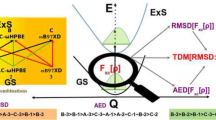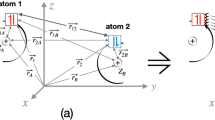Abstract
We present an adaptive density-guided approach for the construction of Born–Oppenheimer potential energy surfaces (PES) in rectilinear normal coordinates for use in vibrational structure calculations. The procedure uses one-mode densities from vibrational structure calculations for a dynamic sampling of PESs. The implementation of the procedure is described and the accuracy and versatility of the method is tested for a selection of model potentials, water, difluoromethane and pyrimidine. The test calculations illustrate the advantage of local basis sets over harmonic oscillator basis sets in some important aspects of our procedure.



Similar content being viewed by others
Notes
In relation with the check of Eq. 15, the extension is set to 1/8 of the initial spanned space. The program evaluates the amount of density recoverable in a specific direction by assuming a linear decay of the density outside the grid boundaries; if the estimated residual density is larger than half of \(\epsilon_{\rho},\) the extension is trigged on. If the condition of Eq. 15 is not fulfilled, but none of the contributions in either direction is found large enough to trigger on the extension, i.e. due to an erroneous estimate of the density recoverable, the grid is extended in both directions with 1/16 of the initial grid domain.
It was found adequate to enforce the support for the localized basis set to be 50% larger (with a maximum allow 20 a.u.). than the space spanned by the evaluation points.
On a Opteron 2.2 GHz processor, 2 GB memory RAM.
A: the 1D surfaces were converged with \(\epsilon_{\rm rel} = 1 \times 10^{-2}\) and \(\epsilon_{\rm abs} = 1 \times 10^{-6},\) whereas the 2D surfaces were converged with \(\epsilon_{\rm rel} = 2.5 \times 10^{-1}\) and \(\epsilon_{\rm abs} = 2.5 \times 10^{-5}.\) Gaussian basis sets were used in the VSCF calculations. B: the 1D surfaces were converged with \(\epsilon_{\rm rel} = 5 \times 10^{-3}\) and \(\epsilon_{\rm abs} = 5 \times 10^{-7},\) whereas the 2D surfaces were converged with \(\epsilon_{\rm rel} = 1.2 \times 10^{-1}\) and \(\epsilon_{\rm abs} = 1.2 \times 10^{-5}\) Gaussian basis sets were used in the VSCF calculations. C: the 1D surfaces were converged with \(\epsilon_{\rm rel} = 3 \times 10^{-3}\) and \(\epsilon_{\rm abs} = 3 \times 10^{-7},\) whereas the 2D surfaces were converged with \(\epsilon_{\rm rel} = 5 \times 10^{-2}\) and \(\epsilon_{\rm abs} = 5 \times 10^{-6}\) Gaussian basis sets were used in the VSCF calculations. D: the 1D surfaces were converged with \(\epsilon_{\rm rel} = 5 \times 10^{-3}\) and \(\epsilon_{\rm abs} = 5 \times 10^{-7},\) whereas the 2D surfaces were converged with \(\epsilon_{\rm rel} = 1.2 \times 10^{-1}\) and \(\epsilon_{\rm abs} = 1.2 \times 10^{-5}\) HO basis sets were used in the VSCF calculations.
References
Carter S, Culik SJ, Bowman JM (1997) J Chem Phys 107:10458
Kongsted J, Christiansen O (2006) J Chem Phys 125:124108
Bowman JM, Carter S, Huang XC (2003) Int Rev Phys Chem 22:533
Jung JO, Gerber RB (1996) J Chem Phys 105:10332
Rauhut G (2004) J Chem Phys 121:9313
Benoit DM (2004) J Chem Phys 120:562
Yagi K, Hirata S, Hirao K (2007) Theor Chem Acc 118:681
Toffoli D, Kongsted J, Christiansen O (2007) J Chem Phys 127:204106
Chaban GM, Jung JO, Gerber RB (1999) J Chem Phys 111:1823
Yagi K, Taketsugu T, Hirao K, Gordon M (2000) J Chem Phys 113:1005
Collins M (2002) Theor Chem Acc 108:313
Manzhos S, Carrington T (2006) J Chem Phys 125:084109
Manzhos S, Carrington T (2007) J Chem Phys 127:014103
Dawes R, Thompson DL, Guo Y, Wagner AF, Minkoff M (2007) J Chem Phys 126:184108
Dawes R, Thompson DL, Wagner AF, Minkoff M (2008) J Chem Phys 128:084107
Maeda S, Watanabe Y, Ohno K (2008) J Chem Phys 128:144111
Huang X, Braams BJ, Bowman JM (2005) J Chem Phys 122:044308
Tew D, Handy N, Carter S (2006) J Chem Phys 125:084313
Vendrell O, Gatti F, Lauvergnat D, Meyer HD (2007) J Chem Phys 127:184302
Pele L, Gerber RB (2008) J Chem Phys 128:165105
Oyanagi C, Yagi K, Taketsugu T, Hirao K (2006) J Chem Phys 124:064311
Midascpp (molecular interactions, dynamics and simulation chemistry program package in c++) (2007). http://www.chem.au.dk/∼midas
Hamilton IP, Light JC (1986) J Chem Phys 84:306
Poirier B, Light J (2000) J Chem Phys 113:211
Partridge H, Schwenke DW (1997) J Chem Phys 106:4618
Dalton, A molecular electronic structure program, release 2.0 (2005). http://www.kjemi.uio.no/software/dalton/dalton.html
Schmidt MW, Baldridge KK, Boatz JA, Elbert ST, Gordon MS, Jensen JH, Koseki S, Matsunaga N, Nguyen KA, Su SJ, Windus TL, Dupuis M, Montgomery JA (1993) J Comput Chem 14:1347
Watson JKG (1968) Mol Phys 15:479
Beck MH, Jackle A, Worth GA, Meyer HD (2000) Phys Rep 324:1
Christiansen O (2007) Phys Chem Chem Phys 9:2942
Bowman JM (1978) J Chem Phys 68:608
Bowman JM (1986) Acc Chem Res 19:202
Gerber RB, Ratner MA (1988) Adv Chem Phys 70:97
Norris LS, Ratner MA, Roitberg AE, Gerber RB (1996) J Chem Phys 105:11261
Christiansen O (2003) J Chem Phys 119:5773
Matsunaga N, Chaban GM, Gerber RB (2002) J Chem Phys 117:3541
Bowman JM, Christoffel K, Tobin F (1979) J Phys Chem 83:905
Christoffel KM, Bowman JM (1982) Chem Phys Lett 85:220
Carter S, Bowman JM, Handy NC (1998) Theor Chem Acc 100:191
Christiansen O (2004) J Chem Phys 120:2149
Christiansen O (2004) J Chem Phys 120:2140
Christiansen O (2005) J Chem Phys 122:194105
Seidler P, Christiansen O (2007) J Chem Phys 126:204101
Seidler P, Hansen MB, Christiansen O (2008) J Chem Phys 128:154113
Coon JB, Naugle NW, Mckenzie RD (1966) J Mol Spectr 20:107
Lin CK, Chang HC, Lin SH (2007) J Phys Chem A 111:9347
Xie T, Bowman JM (2002) J Chem Phys 117:10487
Yanai T, Tew DP, Handy NC (2004) Chem Phys Lett 393:51
Zhao Y, Truhlar D (2008) Theor Chem Acc 120:215
Dunning Jr TH, Hay PJ (1977) In: Schaefer III HF (ed) Modern theoretical chemistry. Plenum Press, New York, p 1
Acknowledgments
This work has been supported by the Lundbeck Foundation, the Danish national research foundation, the Danish Center for Scientific Computing (DCSC), and EUROHORCs through a EURYI award.
Author information
Authors and Affiliations
Corresponding author
Appendix
Appendix
1.1 Integrals for distributed Gaussian basis sets
Gaussian integrals can be easily done analytically from a few standard integrals (\(\int_{-\infty}^\infty e^{-\lambda x^2}\,{\rm d}x=\sqrt{{\frac{\pi} {\lambda}}}, \int_{-\infty}^\infty x^{n} e^{-\lambda x^2}\,{\rm d}x=(-{\frac{\rm d} {{\rm d}\lambda}})^{n/2}\sqrt{{\frac{\pi} {\lambda}}}\) with n an even positive integer number) and the fact that the product of two Gaussians is another Gaussian:
with
The overlap integrals are
Clearly, the basis set of distributed Gaussians is a non-orthogonal basis with overlaps decaying fast with the distance between the centers of the Gaussians and with increasing exponents. Other integrals are
with \((2k-1)!! = (2k-1)\times(2k-3){\ldots}\times 1\) and \(0!!=1.\)
Other integrals have to be computed if the Hamiltonian contains Watson kinetic energy terms, which can be easily derived from the integrals listed above:
When fitting with scaled coordinates all these integrals are multiplied by a common factor of \((\sqrt{\omega})^n\) when the scaled coordinate x enters with a power of n.
Rights and permissions
About this article
Cite this article
Sparta, M., Toffoli, D. & Christiansen, O. An adaptive density-guided approach for the generation of potential energy surfaces of polyatomic molecules. Theor Chem Acc 123, 413–429 (2009). https://doi.org/10.1007/s00214-009-0532-1
Received:
Accepted:
Published:
Issue Date:
DOI: https://doi.org/10.1007/s00214-009-0532-1




